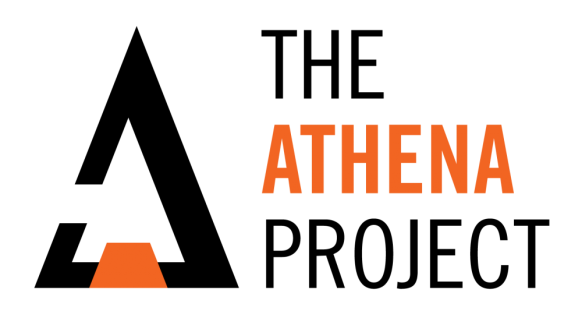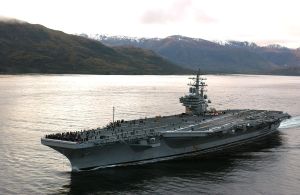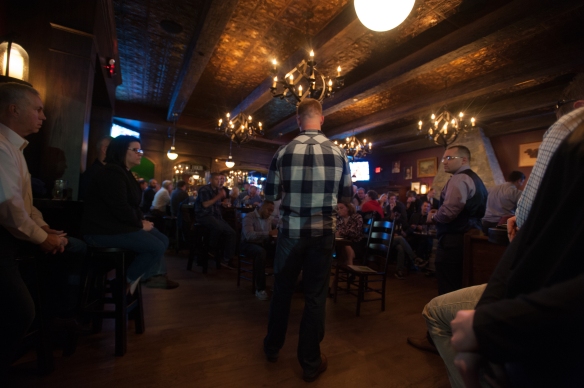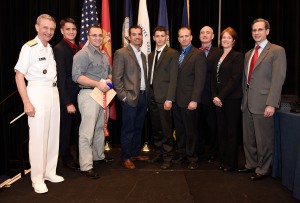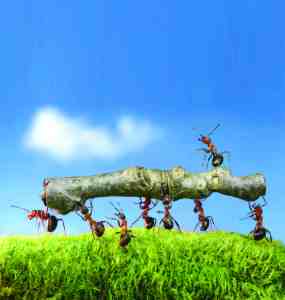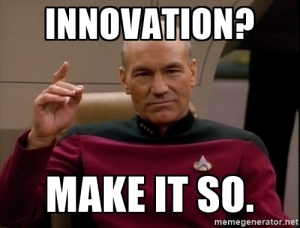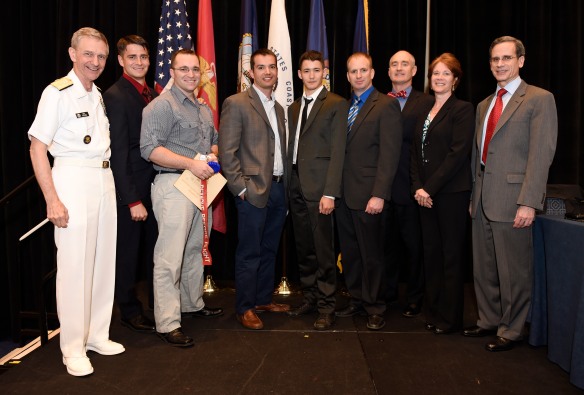By CDR Michele Day
On April 14th, while transiting the South China Sea, USS RONALD REAGAN hosted the first ATHENA project event on an aircraft carrier. The audience, not knowing what to expect, was full of questions and brimming with excitement!
Flight Deck Roomba
LT David Levy
LT Levy’s idea leverages commercial technology to lessen the burden on the flight deck crew by programming a modified Roomba to clean the flight deck during non-flight operations maintenance periods. Many night after flight operations have concluded the aviation maintainers conduct maintenance on the flight deck, where the darkness can make it difficult to find small nuts and bolts when dropped. The Flight deck Roomba would drive a pre-programmed route to assist with clean-up after nighttime maintenance. As Foreign Object Debris (FOD) walk down impacts a large portion of the crew, there was a lot of interest, however LT Levy was adamant that the Flight Deck Roomba would not replace FOD walk down as nothing is as good as the mark-one-mod-zero eyeball for finding FOD. Much of the audience questioned the necessity and value of the flight deck Roomba if it would not replace FOD walk down.
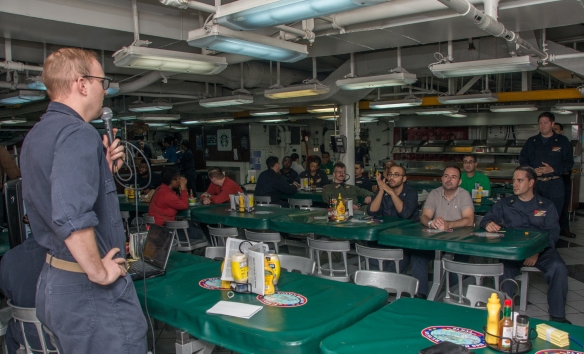
LT Greg Hahn answers questions during the Q&A portion of his pitch.
Custom Boot Insoles
LT Greg Hahn
“How many of you stand on a steel deck for more than 10 hours a day?” posed LT Hahn. Hands across the room shot up from tired and sweaty sailors. He then went on to describe a custom insole made from recycled materials that will not only provide cushion, but will increase cooling and circulation in work boots. LT Hahn stated he did not think the boot manufacturers contracted by the Navy would include custom insoles, but these could easily be purchased after market. During the Q&A session many questions were raised regarding how these insoles are different than insoles already on the market and if the Navy would provide money for purchase of such insoles.
LT Aaron Kakiel
Laser Pointer Alternative
Over the past 10 years we’ve seen the presentation standard move from a stick pointer to the laser pointer and the slide projector five way to the overhead projector and the LCD monitor. LT Kakiel’s idea is to replace the laser pointer with technology that exists in most family homes today by re-purposing the motion capture technology from gaming consoles. He explained two primary benefits; 1) The beam from laser pointers is often refracted when it hits the LCD screen, resulting in the laser beam shining into the audience members’ eyes. 2) The laser pointer presentation does not lend itself to collaboration. By utilizing motion capture technology, more team members can participate in the meetings. During the Q&A session the discussion centered on the need to modify the technology such that random movements (stretching, drinking water, etc) are not captured and displayed on screen.
PRT Spotcheck Program
AOAN Walter Johnson
AOAN Jackson’s pitch was simple and passionate. Far too many sailors prepare for the Physical Fitness Assessment a few weeks before the PFA and then neglect their fitness and diet until the next PFA cycle. By instituting random spot checks, all sailors would be forced to maintain a steady strain approach to working out and eating healthy. During the Q&A session an audience member stated the new PFA instruction had an allowance for commands to conduct spot PFA’s if a member appeared to be in danger of future failures. AOAN Jackson stated he had not read the new PFA instruction, but his idea was for an outside entity, such as ATG, to conduct the spot checks in order to avoid the potential for commands to refrain from spot checking their high performing sailors who were not in the best shape. This led to a lively back and forth exchange across the audience about the need for certain technical skill sets that were very sedentary in nature (e.g. Cyber defense/hacking) and the possibilities of having a portion of the workforce subject to a different set of physical requirements as sea-going sailors need a certain functional strength that sailors in potential land-locked ratings will not require.
Fixing CANES
IT2 Mason Lybrand
CANES onboard USS RONALD REAGAN is the bane of most sailors quality of life at sea. As our young sailors are digital natives, their reliance on the NIPRnet for social networking a top priority. Additionally, most UNCLAS technical manuals are not maintained onboard and many sailors rely on schoolhouse reach back and online distance support for technical trouble shooting. All of our travel and logistics websites reside on the NIPRnet as well. The design of CANES is flawed in that one server supports all inbound and outbound traffic, for the entire carrier. As a result the server is easily overloaded. The additional of an additional server rack would alleviate the load and greatly improve network performance.
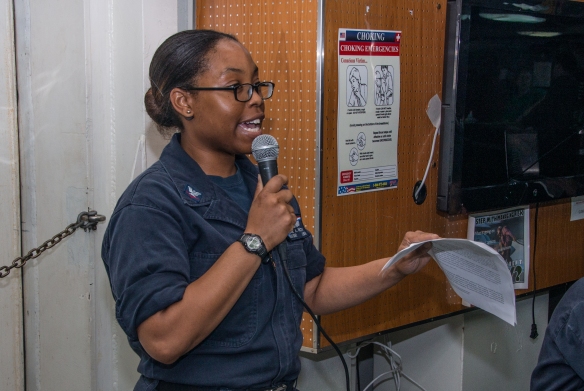
Admiral Sims Award Winner, GM2 Payge Shelton, gets the crowd excited about her pitch for the Hippocampus Stimulator!
Hippocampus Stimulator
GM2 Payge Shelton
***Admiral Sims Award Winner***
GM2 Paige’s pitch was inspired by her experience dealing with two subsets of sailors; 1) Sailors who are smart, but lack a work ethic and only joined the Navy long enough to get the GI Bill and get out, and 2) Sailors who really care about the Navy and work hard, but struggle to pass promotion tests. Her idea is by year 3 or 4, the hardworking, dedicated sailors, would be successfully weeded from the chaff. They could then voluntarily sign-up for Hippocampus Stimulation treatment – either via electrical shock or injection. GM2 Paige expertly explained the science behind Hippocampus stimulation and how the use of stimulation during the learning phase suggests that sailors would not require continuous stimulation to boost their memory, but only when they are trying to learn important information. She also noted that in the future this technology may lead the way to neuro-prosthetic devices that can be turned on and off during specific stages of information processing or daily tasks. This additional cognitive function will give hard working sailors the ability to achieve higher scores on advancement exams and promote ahead of the less motivated sailors. The excitement for this idea was palpable as many sailors in the room expressed frustration with pockets of sailors whose negativity brought everyone down, but was tolerated by leadership because of the individual sailors knowledge and skill. GM2 received the most votes for her idea was well researched and she explained in detail how this technology could be implemented in the Navy in the not too distant future. Her enthusiasm was contagious and by the end of the presentation we had sailors willing to line-up for Hippocampus stimulation now!
ATHENA Far East 4.0 will be later this fall. In the meantime, check out the C7F Innovation Pitchfest on Friday, August 18th, 1300-1600 in room 216 of the MWR building!

